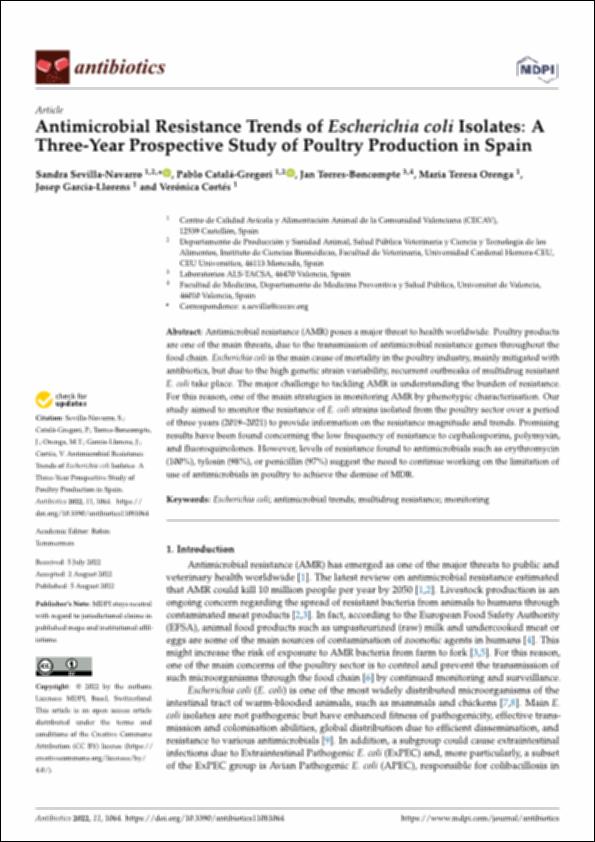Please use this identifier to cite or link to this item:
http://hdl.handle.net/10637/14266Antimicrobial resistance trends of "Escherichia coli" isolates a three-year prospective study of poultry production in Spain
| Title: | Antimicrobial resistance trends of "Escherichia coli" isolates a three-year prospective study of poultry production in Spain |
| Authors : | Sevilla Navarro, Sandra Catalá Gregori, Pablo Torres Boncompte, Jan Orenga Martín, María Teresa García Llorens, Josep Cortés Moñiz, Verónica |
| Keywords: | Aves de corral - Enfermedades infecciosas.; Anti-infective agents in veterinary medicine.; Antiinfecciosos en veterinaria.; Escherichia coli - Resistencia a los medicamentos.; Escherichia coli - Drug resistance.; Poultry - Communicable diseases. |
| Publisher: | MDPI |
| Citation: | Sevilla-Navarro, S., Catalá-Gregori, P., Torres-Boncompte, J., Orenga, M. T., Garcia-Llorens, J. & Cortés, V. (2022). Antimicrobial resistance trends of "Escherichia coli" isolates: a three-year prospective study of poultry production in Spain. Antibiotics, vol. 11, i. 8 (05 aug.), art. 1064. DOI: https://doi.org/10.3390/antibiotics11081064 |
| Abstract: | Antimicrobial resistance (AMR) poses a major threat to health worldwide. Poultry products are one of the main threats, due to the transmission of antimicrobial resistance genes throughout the food chain. Escherichia coli is the main cause of mortality in the poultry industry, mainly mitigated with antibiotics, but due to the high genetic strain variability, recurrent outbreaks of multidrug resistant E. coli take place. The major challenge to tackling AMR is understanding the burden of resistance. For this reason, one of the main strategies is monitoring AMR by phenotypic characterisation. Our study aimed to monitor the resistance of E. coli strains isolated from the poultry sector over a period of three years (2019–2021) to provide information on the resistance magnitude and trends. Promising results have been found concerning the low frequency of resistance to cephalosporins, polymyxin, and fluoroquinolones. However, levels of resistance found to antimicrobials such as erythromycin (100%), tylosin (98%), or penicillin (97%) suggest the need to continue working on the limitation of use of antimicrobials in poultry to achieve the demise of MDR. |
| Description: | Este artículo se encuentra disponible en la siguiente URL: https://www.mdpi.com/2079-6382/11/8/1064 Este artículo de investigación pertenece al número especial "Epidemiology, Impact and Mitigation of Antimicrobial Resistance in Veterinary Medicine". |
| URI: | http://hdl.handle.net/10637/14266 |
| Rights : | http://creativecommons.org/licenses/by/4.0/deed.es |
| ISSN: | 2079-6382 (Electrónico) |
| Language: | es |
| Issue Date: | 5-Aug-2022 |
| Center : | Universidad Cardenal Herrera-CEU |
| Appears in Collections: | Dpto. Producción y Sanidad Animal, Salud Pública Veterinaria y Ciencia y Tecnología de los Alimentos |
Items in DSpace are protected by copyright, with all rights reserved, unless otherwise indicated.


